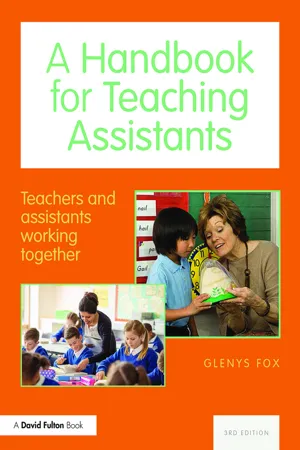
- 180 pages
- English
- ePUB (mobile friendly)
- Available on iOS & Android
About this book
This revised new edition provides essential guidance for all teaching assistants, especially those who are new to the job, and to the teachers working with them. Glenys Fox details the roles and responsibilities of the TA, as well as providing helpful advice on how to best support the teacher, the pupil, the curriculum and the school. This practical handbook will bring experienced TAs up to date on changes to National educational guidance, including changes in the National Curriculum, assessment, and the Special Educational Needs framework. This text enables the assistant and the teacher to work together more effectively in supporting and promoting the progress of children and young people. Written in light of recent research and updates in legislation, this guide will ensure that: teaching assistants know what to expect of colleagues, and vice versapupils are given the best possible support by teaching assistants who understand their needsteaching assistants and teachers are able to work together effectively to support the learning of all children, especially children who have special educational needs and disabilitiesany training received is relevant and helpful. A Handbook for Teaching Assistants is an ideal textbook for training, as well as a useful classroom handbook for teaching assistants working in early years, primary and secondary settings.
Frequently asked questions
- Essential is ideal for learners and professionals who enjoy exploring a wide range of subjects. Access the Essential Library with 800,000+ trusted titles and best-sellers across business, personal growth, and the humanities. Includes unlimited reading time and Standard Read Aloud voice.
- Complete: Perfect for advanced learners and researchers needing full, unrestricted access. Unlock 1.4M+ books across hundreds of subjects, including academic and specialized titles. The Complete Plan also includes advanced features like Premium Read Aloud and Research Assistant.
Please note we cannot support devices running on iOS 13 and Android 7 or earlier. Learn more about using the app.
Information













Table of contents
- Cover-Page
- Halftitle
- Title
- Copyright
- Dedication
- Contents
- Acknowledgements
- Introduction
- 1 The role of the teaching assistant
- 2 How to be an effective teaching assistant
- 3 Supporting the pupil
- 4 Supporting the teacher
- 5 Supporting the curriculum
- 6 Supporting the school
- 7 Promoting effective learning
- 8 Special educational needs
- 9 Supporting children and young people with special educational needs
- 10 Supporting social, emotional, behavioural and mental health needs
- 11 The role of school managers and special needs coordinators
- 12 The role of the teacher working with the teaching assistant
- 13 The professional development needs of teaching assistants
- Some final comments
- Appendix A: Job description
- Appendix B: The roles of supporting professionals
- Appendix C: Glossary of abbreviations
- References